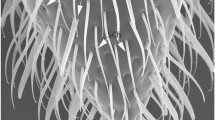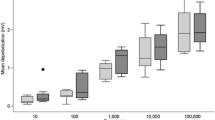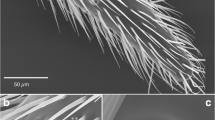Abstract
Electroantennogram responses of male and femalePseudaletia unipuncta to the two major components of the presumed pheromone associated with the male anterior abdominal scent brushes vary with age. There is a postemergence period of maturation of responsiveness, followed by senescence. The age of maximum responsiveness differs according to the sex and to the compound tested.
Similar content being viewed by others
References
Albert, P.J., Seabrook, W.D., andPaim, U. 1974. Isolation of a sex pheromone receptor in the male eastern spruce budwormChoristoneura fumiferana (Clem.).J. Camp. Physiol. 91:79–89.
Birch, M. 1971. Intrinsic limitations in the use of electroantennograms to bioassay male pheromones in Lepidoptera.Nature 233:57–58.
Boeckh, J. 1969. Electrical activity in olfactory receptor cells, pp. 34–51,in Carl Pfaffmann (ed.). Olfaction and Taste, Vol. III. Rockefeller University Press, New York.
Boeckh, J.,Kaissling, K.-E., andSchneider, D. Insect olfactory receptors. Cold Spring Harbor Symp. Quant. Biol. 30:263–280.
Dickens, J.C., andPayne, T.L. 1977. Bark beetle olfaction: Pheromone receptor system inDendroctonus frontalis.J. Insect Physiol. 23:481–490.
Grant, G.G. 1971. Electroantennogram responses to the scent brush secretions of several male moths.Ann. Entomol. Soc. Am. 64:1428–1431.
Grant, G.G., Brady, U.E., andBrand, J.M. 1972. Male armyworm scent brush secretion: Identification and electroantennogram study of major components.Ann. Entomol. Soc. Am. 65:1224–1227.
Kaissling, K.-E. 1969. Kinetics of olfactory receptor potentials, pp. 52–70,in Carl Pfaffmann (ed.). Olfaction and Taste, Vol. III. Rockefeller University Press, New York.
Kaissling, K.-E. 1971. Insect olfaction, pp. 351–531,in L.M. Beidler (ed.). Handbook of Sensory Physiology. Springer, New York.
Kasang, G., andKaissling, K.-E. 1971. Specificity of primary and secondary olfactory processes in theBombyx antenna, pp. 200–206in D. Schneider (ed.). International Symposium on Olfaction and Taste, Vol. IV. Wissenschaftliche Verlagsgesellschaft, Stuttgart.
Payne, T.L., Shorey, H.H., andGaston, L.K. 1970. Sex pheromones of noctuid moths: Factors influencing antennal responsiveness in males ofTrichoplusia ni.J. Insect Physiol. 16:1043–1055.
Roelofs, W.L. 1977. The scope and limitations of the electroantennogram technique in identifying pheromone components, pp. 147–168, in N.R. McFarlane (ed.). Crop Protection Agents. Academic Press, London.
Roelofs, W.L., andComeau, A. 1971a. Sex pheromone perception: Synergists and attractants for the redbanded leafroller attractant.J. Insect Physiol. 17:435–448.
Roelofs, W.L., andComeau, A. 1971b. Sex pheromone perception: Electroantennogram responses of the redbanded leaf roller moth.J. Insect Physiol. 17:1969–1982.
Schweitzer, E.S., Sanes, J.R., andHildebrand, J.G. 1976. Ontogeny of electroantennogram responses in the mothManduca sexta.J. Insect Physiol. 22:955–960.
Shorey, H.H., andGaston, L.K. 1964. Sex pheromones of noctuid moths. III. Inhibition of male responses to the sex pheromone inTrichoplusia ni (Lepidoptera, Noctuidae).Ann. Entomol. Soc. Am. 57:775–779.
Shorey, H.H., andHale, R.L. 1965. Mass rearing of larvae of nine noctuid species on a simple artificial medium.J. Econ. Entomol. 58:522–524.
Author information
Authors and Affiliations
Additional information
This research was supported in part by NSF grant BNS76-10268 and grants from the Killam Foundation and the Rockefeller Foundation.
Rights and permissions
About this article
Cite this article
Seabrook, W.D., Hirai, K., Shorey, H.H. et al. Maturation and senescence of an insect chemosensory response. J Chem Ecol 5, 587–594 (1979). https://doi.org/10.1007/BF00987843
Received:
Revised:
Issue Date:
DOI: https://doi.org/10.1007/BF00987843




